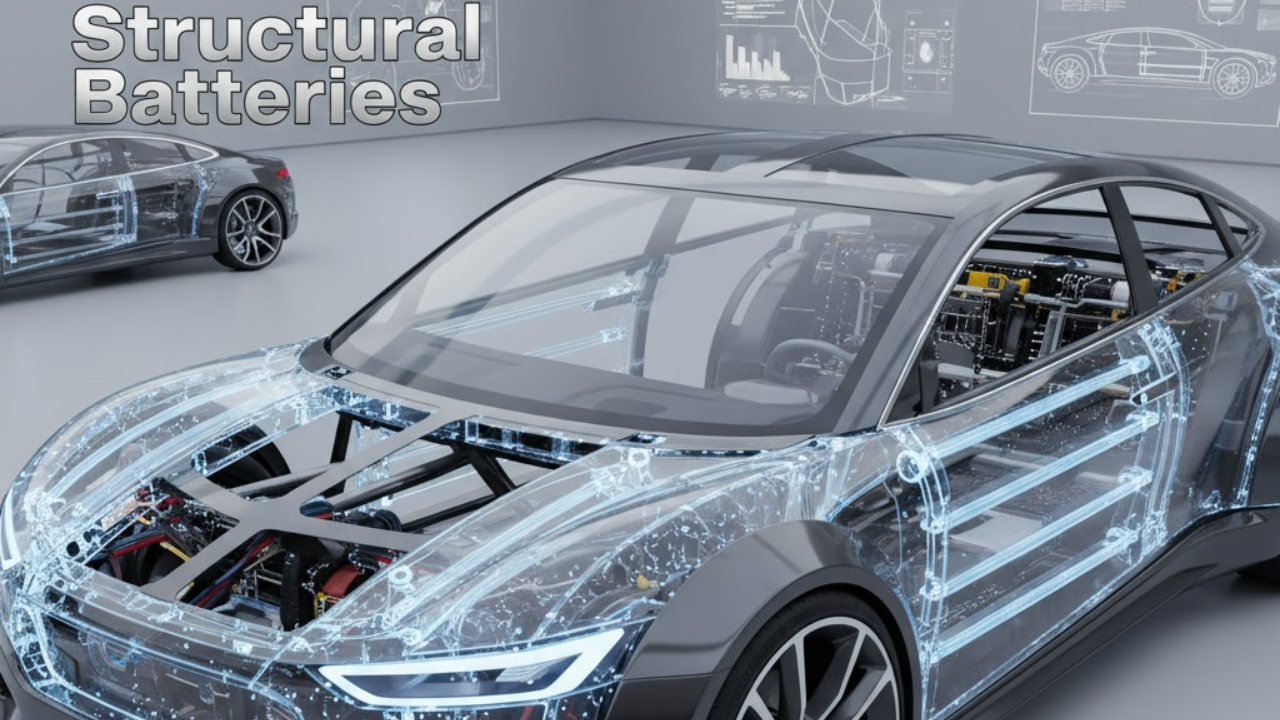
Post by : Naveen Mittal
Electric vehicles and aircraft are on the brink of a transformation — one where their bodies won’t just support movement, but also store the energy that powers them. The concept driving this change is called Structural Battery Composites (SBCs), and it’s poised to redefine how we think about energy storage and design.
Today’s electric vehicles depend on massive lithium-ion battery packs that make up nearly half of their total weight. But what if those heavy cells could disappear, replaced by materials that are strong and energy-storing at the same time?
That’s the promise of structural batteries — composite materials that double as both the skeleton and the power source of a machine. These composites are made from carbon fibers infused with lithium-conducting polymers, turning the very frame of a car or plane into a living energy network.
Electric vehicle manufacturers are racing to solve one major problem: range anxiety without adding bulk. Structural battery composites may be the missing piece.
By embedding energy storage directly into body panels, roofs, and chassis components, engineers could:
Eliminate bulky battery packs.
Free up cabin and trunk space.
Extend range without increasing overall mass.
Researchers at Chalmers University of Technology achieved a breakthrough with a carbon-fiber composite that’s both as strong as aluminum and capable of storing energy. Companies like Tesla, BMW, and Polestar are already exploring prototypes that use this concept for next-generation EVs.
The result could be electric cars that are lighter, faster, and more energy-efficient — not by adding batteries, but by becoming them.
While the automotive sector pushes toward electrification, the aerospace industry sees an even greater opportunity. In aviation, every kilogram saved translates to major gains in performance and fuel efficiency.
Airbus and Rolls-Royce are testing composite airframes that can hold electric charge, potentially reducing aircraft weight by up to 25%. Imagine wings that store power for takeoff or fuselages that act as giant batteries during flight.
This innovation could make electric aircraft viable for commercial use, especially in regional travel — where current battery packs are too heavy for sustained flight.
To understand how this technology works, think of a sandwich structure:
The carbon fiber layers act as the electrodes (anode and cathode).
A solid polymer electrolyte lies between them, conducting lithium ions.
When current flows, ions move through the electrolyte, just like in a conventional battery — but the composite also carries structural loads. It’s both mechanically strong and electrochemically active.
Recent research in solid-state electrolytes has made these materials safer, eliminating risks like overheating or leakage while increasing energy density.
Structural batteries could reshape how vehicles and aircraft are designed:
Form follows function: Designers can integrate energy storage into the aesthetic form of a car or aircraft.
Improved efficiency: A lighter structure means higher mileage and longer flight times.
Sustainability edge: Fewer components mean reduced material waste and lower carbon footprint.
Even beyond transportation, this technology could find use in consumer electronics, wearables, and smart infrastructure, where compact and flexible energy sources are in demand.
Market analysts predict a boom in energy-storing structural materials, with the industry projected to exceed $3 billion by 2032.
Automakers such as Polestar and Volvo have already partnered with Chalmers University to create early prototypes, aiming for the first commercial structural battery EV within this decade.
Though promising, the technology faces hurdles before mass production:
Energy density: Still lower than current lithium-ion cells.
Cost: Advanced carbon composites remain expensive.
Repair complexity: Fixing damaged energy-storing structures requires specialized expertise.
But these limitations are shrinking quickly as nanomaterial research and AI-powered design tools advance. Many experts believe that within a decade, SBCs will be as common as lithium-ion batteries are today.
Structural batteries symbolize more than an engineering milestone — they represent a shift in thinking. Instead of viewing power sources as separate components, designers can now integrate them directly into the skeleton of machines.
As one Chalmers researcher put it: “The future car will not have a battery — it will be one.”
From next-gen electric vehicles to energy-storing aircraft, structural composites could unlock a future where every structure around us is alive with power — strong, smart, and self-charging.










Paramount+ Wins Five-Year Deal to Stream PBR’s 'Unleash the Beast'
Paramount+ has inked a five-year streaming agreement to carry PBR's Unleash the Beast live from Dece

Zohran Mamdani's Historic NYC Win Marked by Bollywood Finale
Zohran Mamdani captured the New York mayoralty — the city's first Muslim and South Asian mayor — and

Indian Tennis Veteran Rohan Bopanna Ends Illustrious Career
Rohan Bopanna retires from tennis at 45 after winning two Grand Slams, becoming world number one, an

Babar Azam Becomes Top Run Scorer In T20I Cricket History
Pakistan’s Babar Azam has overtaken India’s Rohit Sharma to become the highest run-scorer in men’s T

BTS Comeback 2026 Group Plans Biggest-Ever Global Tour
BTS is set for a long-awaited comeback in 2026, followed by a massive 65-city world tour. Fans hope

India Stuns Australia to Reach Women’s World Cup Final
India shocked seven-time champions Australia in the Women’s World Cup semi-final, chasing 339 runs w